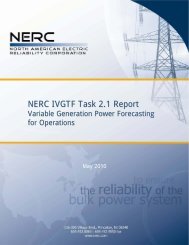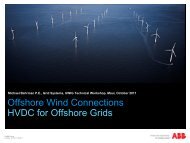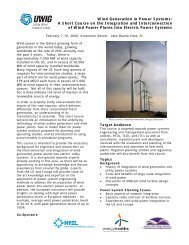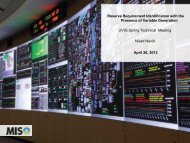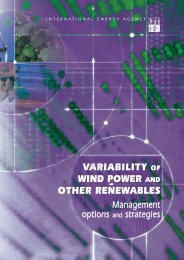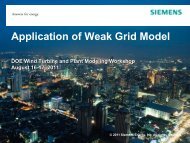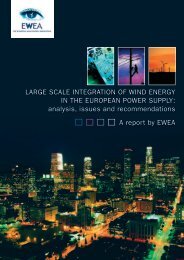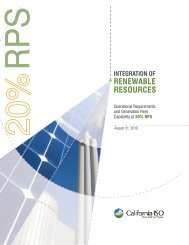Integrating Southwest Power Pool Wind to Southeast Electricity ...
Integrating Southwest Power Pool Wind to Southeast Electricity ...
Integrating Southwest Power Pool Wind to Southeast Electricity ...
Create successful ePaper yourself
Turn your PDF publications into a flip-book with our unique Google optimized e-Paper software.
EXECUTIVE SUMMARY<br />
This DOE-funded project titled “<strong>Integrating</strong> <strong>Southwest</strong> <strong>Power</strong> <strong>Pool</strong> <strong>Wind</strong> Energy in<strong>to</strong> <strong>Southeast</strong><br />
<strong>Electricity</strong> Markets” aims <strong>to</strong> evaluate the benefits of coordination of scheduling and balancing<br />
for <strong>Southwest</strong> <strong>Power</strong> <strong>Pool</strong> (SPP) wind transfers <strong>to</strong> <strong>Southeast</strong>ern Electric Reliability Council<br />
(SERC) Balancing Authorities (BAs). The primary objective of this project is <strong>to</strong> analyze the<br />
benefits of different balancing approaches with increasing levels of inter-regional cooperation.<br />
Scenarios were defined, modeled and investigated <strong>to</strong> address production variability and<br />
uncertainty and the associated balancing of large quantities of wind power in SPP and delivery <strong>to</strong><br />
energy markets in the western regions of SERC.<br />
The study evaluates the scheduling/balancing challenges associated with delivery of sufficient<br />
wind generation from within the SPP footprint <strong>to</strong> support 20% energy from renewable resources<br />
across the SPP, Entergy (EES), Southern Company (SoCo), and the Tennessee Valley Authority<br />
(TVA) balancing areas for the year 2022. The project team worked closely with staff from each<br />
of these companies <strong>to</strong> develop a model of the possible generation fleets within each BA. Based<br />
on the 2022 generation plans identified, specific wind generation sites within the SPP footprint<br />
were identified <strong>to</strong> yield sufficient energy output <strong>to</strong> allow each of the 4 BAs <strong>to</strong> meet the net<br />
renewable energy requirement beyond the renewable energy from the base generation fleet. As<br />
the effort required for transmission planning for increased amounts of wind was outside the<br />
scope of the project, transmission constraints were ignored and a transportation model was used.<br />
The Eastern Interconnect wind generation data set developed by the National Renewable Energy<br />
Labora<strong>to</strong>ry (NREL) was utilized for identifying specific wind plants with SPP for both internal<br />
SPP consumption and for delivery <strong>to</strong> the SERC BAs.<br />
The primary analyses for the project include statistical analysis of wind and load data <strong>to</strong><br />
determine the impact on reserve requirements for each BA and unit commitment (UC) and<br />
economic dispatch (ED) simulations of the SPP-SERC regions as modeled for the year 2022.<br />
These evaluations are made for a 14 GW wind generation scenario where SPP wind generation is<br />
intended for serving only SPP load and for 4 separate high wind (48 GW) transfer balancing<br />
scenarios relative <strong>to</strong> the coordination between regions within the footprint:<br />
1. Hourly Scheduling: SPP carries all additional within-hour reserves for the wind<br />
generation for all SPP and SERC regions. Each BA schedules its own generation dayahead<br />
<strong>to</strong> meet its own forecast load and reserve requirements based on forecast wind<br />
generation from the SPP wind plants assigned <strong>to</strong> each BA without consideration of<br />
generation in neighboring BAs. Note that a variation of the Hourly Scheduling<br />
simulation (“Integration Proxy”) was conducted where all wind generation was assumed<br />
<strong>to</strong> be perfectly forecast & no additional reserve was required for within-hour variability<br />
of wind. This case was conducted as a hypothetical case <strong>to</strong> provide a measure of the<br />
balancing costs associated with the wind generation by comparison <strong>to</strong> the Hourly<br />
Scheduling base case.<br />
2. Dynamic Scheduling: Each SERC BA and SPP individually carries reserves for its wind<br />
generation output even though all wind is located in the SPP footprint. As with scenario<br />
#1, each BA schedules its own generation day-ahead <strong>to</strong> meet its own load and reserve<br />
requirements without consideration of generation from neighboring areas.<br />
iv




